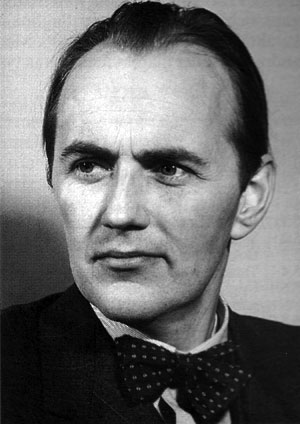<Back to Index>
- Economist Lars Gösta Rehn, 1913
- Economist Rudolf Alfred Meidner, 1914
PAGE SPONSOR

Lars Gösta Rehn, born on 14 February 1913 in Little Malma, Södermanland, died December 1, 1996 in Djursholm, was a Swedish economist and professor at the Institute for Social Research at Stockholm University.
Rehn studied at the School of Social Work and at Stockholm University (then University of Stockholm) 1933 - 36. After graduating from the School of Social Work, he continued studies at the university. In 1940 he participated as a volunteer in the Finnish Winter War. In the late 1930s he began working part time for the Trade Union as an economist at the research department and from 1943 became a full time employee.
Between 1952 - 58 he worked on labor market issues for the two committees at government level. Portions of this work were presented as a licentiate thesis in economics. Between 1959 - 62 Rehn was employed at the Ministry of Finance as head of the government's economic forecasts and analyses of the effects of fiscal policy. In 1962 he became head of the Division of Labor and Social Affairs at the OECD in Paris. Between 1973 - 79 he was director of the Institute for Social Research, Stockholm University, where he lectured and conducted research even after his retirement.
Together with Rudolf Meidner, he developed the so-called Rehn - Meidner model of full employment and low inflation. Rehn and Meidner were also authors of the wage policy of solidarity, that is, the wage policy model that was driven by the LO from the early 1950s to the late 1980's, and that was one of the foundations of the Swedish model of the labor market.

Rudolf Alfred Meidner (23 June 1914 in Breslau, Silesia - 9 December 2005 in Lidingö, Sweden) was a Swedish economist.
Son of Alfred Meidner and Elise Bandmann. Being Jewish and a Socialist he was forced to flee Nazi Germany after the Reichstag fire in Berlin 1933. In 1937 he was married to Ella Jörgenssen. He became a citizen of Sweden in 1943.
He was an economist and the developer of the employee funds as they were proposed by the Swedish Trade Union Confederation in the 1970s. He studied with the famous economist and Nobel Prize Winner Gunnar Myrdal. He got his PhD in 1954 with a dissertation labeled "Swedish Labor Market at Full Employment".
He spent most of his work life at the Swedish Trade Union Confederation as a researcher.
Meidner and another Swedish economist, Gösta Rehn, were responsible for the Rehn - Meidner model for economic growth as promulgated by the Swedish Social Democratic Party and the blue collar trade union, the LO. The Rehn - Meidner model was first proposed in 1951, and for over the next 25 years was the basis for the low inequality, high tech oriented, rapid innovation Swedish economy, which also was exposed to international trade and became export oriented. In response to the increasing demand on the part of workers, communities, and women for a share of the excess profits (permitted by a capital - labor - state wage suppression agreement) accumulated in an increasingly powerful capitalist sector, Rudolf Meidner created a proposal in 1976, published by the LO, that called for requiring all companies above a certain size to issue new stock shares to workers, so that within 20 years the workers would control 52% of the companies they worked in. This policy followed in Meidner's career long efforts to build a step wise, peaceful, institutionally supported transition to a socialist society whose carefully crafted incentive structure and culture would allow each member of society to work and contribute according to her or his capacity, and receive social support according to her or his needs. Supported by important Swedish policy designer Walter Korpi, Meidner's work was opposed by pro - capitalist Social Democrats, including the aggressively conservative Finance Minister Kjell - Olof Feldt, as well as Gosta Rehn (proponent of Active Labor Market Policies) and Olof Palme. The increasing ambitions and occasional militancy of the Swedish working class in conjunction with Meidner's careful, progressive socialist institutional planning politicized the Swedish capitalist class, via the Swedish Employers Foundation (SAF), who joined other countries' capitalist classes ramping up their political efforts to destroy working class organizational bases and to promote the capital deregulation and mobility that began to come to obvious crisis in the 2000s. The SAF's response was to model their political and policy strategies after the New Zealand capitalist class' campaign, which had successfully destroyed a labor movement of similar strength to the Swedish labor movement.
The Rehn - Meidner model resulted in Sweden having a very egalitarian wage system, so that wage differentials between professions was very low, fortifying a low Gini coefficient. However, in the absence of the socialist steps urged by Meidner in the 1970s, the economic model resulted in capital concentration (Despite a very active social policy, Sweden has one of the highest percentages of private ownership of capital in the world.) to the point where in the late 1970s, 25% of share capital was held by the top 0.1% of shareholders and 75% by the top 10%. For the time being, the progressive taxation and pro - middle class state institutions promoted by the model extensively ameliorate this capital concentration, as can be seen in comparatively successful, egalitarian outcomes.